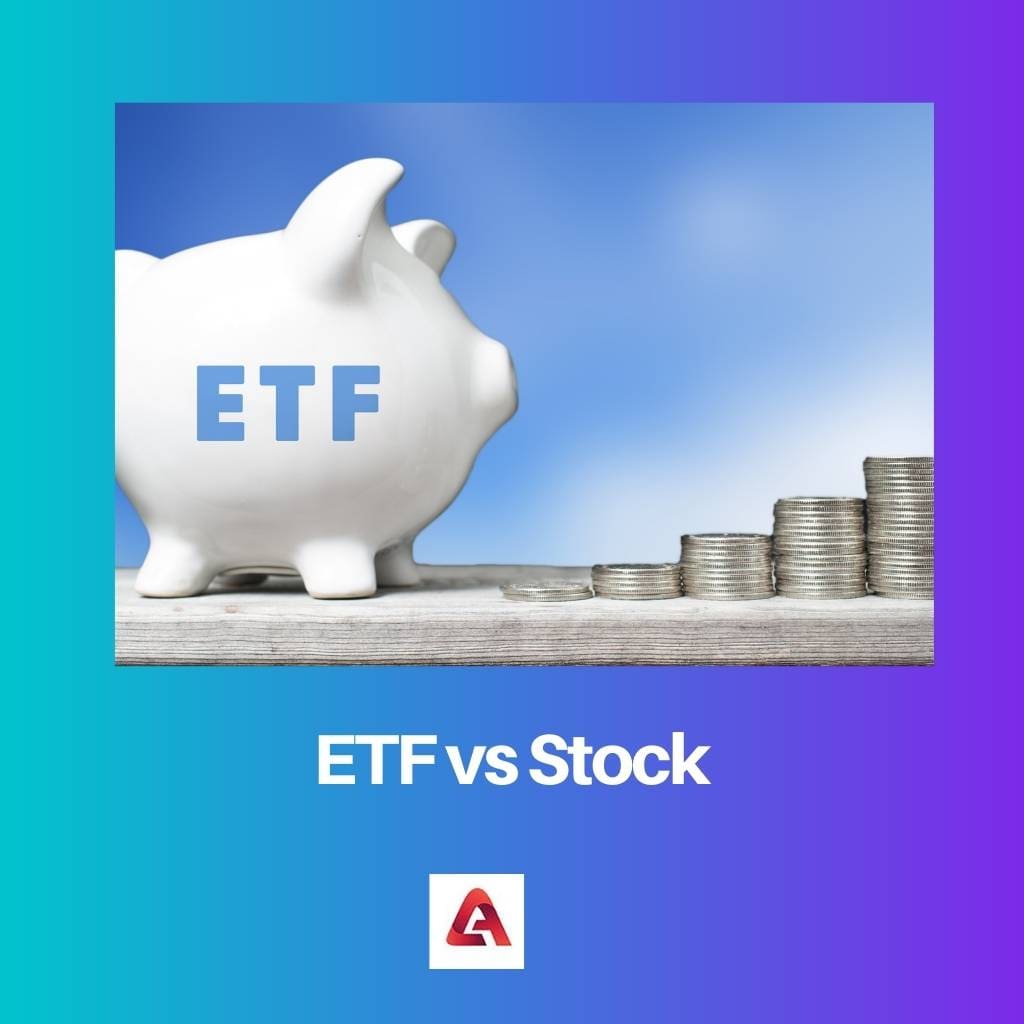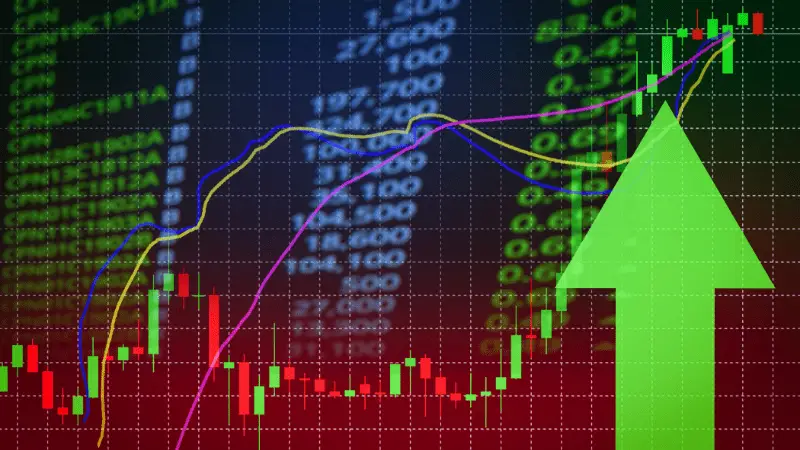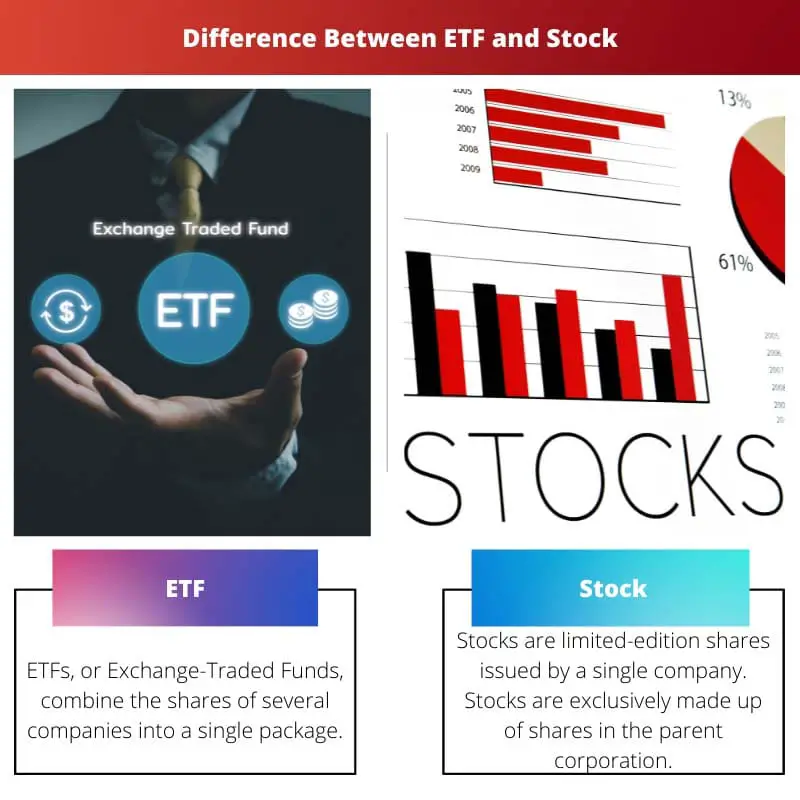Many investors like to combine ETFs and Stocks in their portfolios because each has its own set of benefits.
At the end of the day, it’s all about comprehending their parallels and distinctions, as well as how one or both of them might fit into your investment strategy. Both stocks and ETFs are easy to trade and offer a low-cost entrée into the market.
Key Takeaways
- ETF stands for Exchange-Traded Fund, while Stock represents ownership in a company.
- ETFs are diversified investment funds that trade like a stock, while Stocks represent ownership in a single company.
- ETFs are considered a lower-risk investment than individual stocks, as they offer built-in diversification.
ETF vs Stock
The difference between ETF and Stock is that ETFs can be made up of shares from a single industry, such as IT, technology, or healthcare, or they can be made up of shares from a variety of industries, such as technology healthcare, and many more. However, on the contrary, Stocks have a fixed number of shares. In layman’s terms, an ETF is a fund that invests in the entire market. However, buying stocks is equal to investing in a single corporation or company, according to the average man’s understanding.

ETFs, or Exchange-Traded Funds, are a type of mutual fund that combines the shares of several different companies into one package. The amount or number of shares in an ETF fluctuates over time based on its Net Asset Value.
When the return generated by equities has a limited dispersion that is approximated and computed around the mean, investing in exchange-traded funds, or ETFs, is advantageous.
Stocks are individual company shares. Only the parent company’s stock is included in stocks. Secondary offerings, splits, and stock purchases may cause a change in the number of shares, but this is not required.
When the returns generated by a company offer a significant dispersion from the mean, investing in individual stocks of particular companies is profitable. People who have adequate time to follow the market or who work in the same industry enjoy it.
Comparison Table
| Parameters of Comparison | ETF | Stock |
|---|---|---|
| Company shares | Offer multiple company’s shares. | Offers individual firm only. |
| Number of shares | Changes by NAV. | It remains stable but can change. |
| Sectors involved | Involves particular sectors or multiple sectors. | Involves shares of its parent company only. |
| Layman understanding | Investing in the market as a whole. | Investing in a single firm or company. |
| Advantageous when? | When the return generating from stocks offers a narrow dispersion. | When the returns generating from the company offers a wide dispersion. |
| Interested people | Those who do not have much time to study the market. | Those who have sufficient time to study the market. |
What is ETF?
ETFs, or Exchange-Traded Funds, combine the shares of several companies into a single package.
ETFs can be made up of shares from a single sector, such as IT, technology, or healthcare, or they can be made up of shares from numerous sectors, such as technology, healthcare, and many more.
In layman’s terms, an ETF is a fund that invests in the entire market. When the return generated by equities has a limited dispersion that is approximated and computed around the mean, investing in exchange-traded funds, or ETFs, is advantageous.
People who want to invest but don’t have a lot of time to research the market invest in ETFs or exchange-traded funds. The size or number of shares in an ETF varies over time depending on the Net Asset Value.

What is Stock?
Stocks are limited-edition shares issued by a single company. Stocks are exclusively made up of shares in the parent corporation. In the case of stocks, the number of shares is steady and not fluctuating.
Individual stocks are preferred by people who have enough time to watch the market or who work in the same area.
Secondary offerings, splits, and stock buyers may all be reasons for a change in the number of shares, but this isn’t required. Buying stocks, in the eyes of the average person, is the same as investing in a single corporation or company.
When the returns generated by a company offer a significant dispersion from the mean, investing in individual stocks of individual enterprises is profitable. People who have the time to monitor the market or who work in the same area prefer it.

Main Differences Between ETF and Stock
- ETF or Exchange-Traded Funds offer multiple companies’ shares as a bundle. On the other hand, stocks refer to those shares which are from an individual firm only.
- ETFs either comprise shares from a particular sector, like IT, technology, or healthcare, or they comprise shares from multiple sectors which combine technology, healthcare, and many more. On the other hand, stocks comprise shares of its parent company only.
- In the case of an ETF, the amount or number of shares changes with time according to the Net Asset Value. On the other hand, in the case of stocks, the number of shares are maintained and not unstable. However, this is not mandatory, secondary offerings split, and stock buyers may be the reason for a change in the number of shares.
- In layman’s terms, ETF refers to investing in the market as a whole. On the other hand, according to the common man’s understanding buying stocks is equivalent to investing in a single firm or company.
- Investing in exchange-traded funds or ETFs is advantageous when the return generated from stocks offers a narrow dispersion which is estimated and calculated around the mean. On the other hand, investing in individual stocks of individual firms is advantageous when the returns generated from the company offer a wide dispersion from the mean.
- People who have a keen interest in investing, but do not have much time to study the market, invest in ETF or exchange trading funds. On the other hand, people who have enough time to track the market or who are employed in the same field prefer investing in individual stocks.




